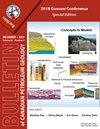通过先进的地下地球细胞地球建模实现跨学科协作和正演建模
Q3 Earth and Planetary Sciences
引用次数: 1
摘要
在许多情况下,我们的行业已经变得非常专注于管理大量数据,寻找简单的相关性,使他们能够捕获适用于资产规划和油田开发的有用信息。这种方法的一个关键问题是,它总是向后看,以确定前进的道路。从本质上讲,这个过程是反动的,很难发现真正创新的机会。在评估了行业地位之后,研究人员研究了一种新的方法,可以将数据和信息持续输入到不断发展的地下地球细胞地球建模工具中。这将代表传统建模工具的重大变化,传统建模工具由于收集和处理新信息所需的时间和精力而受到限制,然后通过整个建模过程进行工作。这种新方法需要一种能够连续接收新信息并快速更新的地球元胞模型。正演建模提供了一个单一的环境,地球科学家和工程师可以一起工作,提高他们对储层的理解,利用最新一代的工具来模拟因果关系,并快速建立优化的油田开发解决方案。统计工具对于监测性能仍然非常有用,但这些数据也用于校准设计工具,以便对地下geocellular模型和正演建模工具进行持续改进。通过实现这一目标,创建了一个共同的协作环境,地球科学家和工程师可以利用最新和最相关的地下信息和知识进行协作和工作。这个概念已经在许多概念验证项目中进行了测试,并显示出非常有希望的结果,本文详细讨论了其中一个项目。本文章由计算机程序翻译,如有差异,请以英文原文为准。
Enabling Cross-discipline Collaboration and Forward Modeling through Advanced Subsurface Geocellular Earth Modeling
Abstract In many situations, our industry today has become very focused on managing huge quantities of data, looking for simple correlations that would enable them to capture useful information applicable to asset planning and field development. One of the key issues with this approach is that it is always looking backward to determine the path forward. By nature, this process is reactionary, making it difficult to identify opportunities for real innovation. Having assessed the industry position, a new approach was examined where data and information could be continuously fed into an evolving sub-surface geocellular earth modeling tool. This would represent a significant change from the traditional modeling tools where changes are limited due to the time and effort required to collect and process new information, then work through the entire modeling process. This new approach requires a geocellular earth model that is capable of receiving new information continuously and updating quickly. Forward modeling in this way provides a single environment where geoscientists and engineers can work together to improve their understanding of the reservoir, leverage the latest generation of tools to model cause and effect behaviors, and quickly establish optimized field development solutions. Statistical tools are still very useful for monitoring performance, but this data is also used to calibrate design tools to enable continuous refinement to the subsurface geocellular model and forward modeling tools. By accomplishing this, a common collaboration environment is created where both geoscientists and engineers can collaborate and work with the most current and most relevant subsurface information and knowledge. This concept has been tested in a number of proof-of-concept projects that have shown very promising results, one of which is discussed in detail in this paper.
求助全文
通过发布文献求助,成功后即可免费获取论文全文。
去求助
来源期刊

Bullentin of Canadian Petroleum Geology
Earth and Planetary Sciences-Geochemistry and Petrology
CiteScore
2.50
自引率
0.00%
发文量
0
期刊介绍:
The Bulletin of Canadian Petroleum Geology is a peer-reviewed scientific journal published four times a year. Founded in 1953, the BCPG aims to be the journal of record for papers dealing with all aspects of petroleum geology, broadly conceived, with a particularly (though not exclusively) Canadian focus. International submissions are encouraged, especially where a connection can be made to Canadian examples.
 求助内容:
求助内容: 应助结果提醒方式:
应助结果提醒方式:


